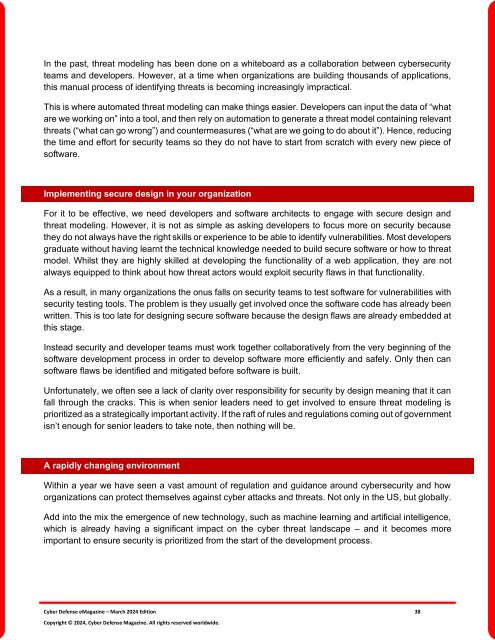The Cyber Defense eMagazine March Edition for 2024
Cyber Defense eMagazine March Edition for 2024 #CDM #CYBERDEFENSEMAG @CyberDefenseMag by @Miliefsky a world-renowned cyber security expert and the Publisher of Cyber Defense Magazine as part of the Cyber Defense Media Group as well as Yan Ross, Editor-in-Chief and many more writers, partners and supporters who make this an awesome publication! 225 page March Edition fully packed with some of our best content. Thank you all and to our readers! OSINT ROCKS! #CDM #CDMG #OSINT #CYBERSECURITY #INFOSEC #BEST #PRACTICES #TIPS #TECHNIQUES
Cyber Defense eMagazine March Edition for 2024 #CDM #CYBERDEFENSEMAG @CyberDefenseMag by @Miliefsky a world-renowned cyber security expert and the Publisher of Cyber Defense Magazine as part of the Cyber Defense Media Group as well as Yan Ross, Editor-in-Chief and many more writers, partners and supporters who make this an awesome publication! 225 page March Edition fully packed with some of our best content. Thank you all and to our readers! OSINT ROCKS! #CDM #CDMG #OSINT #CYBERSECURITY #INFOSEC #BEST #PRACTICES #TIPS #TECHNIQUES
You also want an ePaper? Increase the reach of your titles
YUMPU automatically turns print PDFs into web optimized ePapers that Google loves.
In the past, threat modeling has been done on a whiteboard as a collaboration between cybersecurity<br />
teams and developers. However, at a time when organizations are building thousands of applications,<br />
this manual process of identifying threats is becoming increasingly impractical.<br />
This is where automated threat modeling can make things easier. Developers can input the data of “what<br />
are we working on” into a tool, and then rely on automation to generate a threat model containing relevant<br />
threats (“what can go wrong”) and countermeasures (“what are we going to do about it”). Hence, reducing<br />
the time and ef<strong>for</strong>t <strong>for</strong> security teams so they do not have to start from scratch with every new piece of<br />
software.<br />
Implementing secure design in your organization<br />
For it to be effective, we need developers and software architects to engage with secure design and<br />
threat modeling. However, it is not as simple as asking developers to focus more on security because<br />
they do not always have the right skills or experience to be able to identify vulnerabilities. Most developers<br />
graduate without having learnt the technical knowledge needed to build secure software or how to threat<br />
model. Whilst they are highly skilled at developing the functionality of a web application, they are not<br />
always equipped to think about how threat actors would exploit security flaws in that functionality.<br />
As a result, in many organizations the onus falls on security teams to test software <strong>for</strong> vulnerabilities with<br />
security testing tools. <strong>The</strong> problem is they usually get involved once the software code has already been<br />
written. This is too late <strong>for</strong> designing secure software because the design flaws are already embedded at<br />
this stage.<br />
Instead security and developer teams must work together collaboratively from the very beginning of the<br />
software development process in order to develop software more efficiently and safely. Only then can<br />
software flaws be identified and mitigated be<strong>for</strong>e software is built.<br />
Un<strong>for</strong>tunately, we often see a lack of clarity over responsibility <strong>for</strong> security by design meaning that it can<br />
fall through the cracks. This is when senior leaders need to get involved to ensure threat modeling is<br />
prioritized as a strategically important activity. If the raft of rules and regulations coming out of government<br />
isn’t enough <strong>for</strong> senior leaders to take note, then nothing will be.<br />
A rapidly changing environment<br />
Within a year we have seen a vast amount of regulation and guidance around cybersecurity and how<br />
organizations can protect themselves against cyber attacks and threats. Not only in the US, but globally.<br />
Add into the mix the emergence of new technology, such as machine learning and artificial intelligence,<br />
which is already having a significant impact on the cyber threat landscape – and it becomes more<br />
important to ensure security is prioritized from the start of the development process.<br />
<strong>Cyber</strong> <strong>Defense</strong> <strong>eMagazine</strong> – <strong>March</strong> <strong>2024</strong> <strong>Edition</strong> 38<br />
Copyright © <strong>2024</strong>, <strong>Cyber</strong> <strong>Defense</strong> Magazine. All rights reserved worldwide.

















